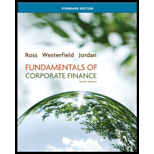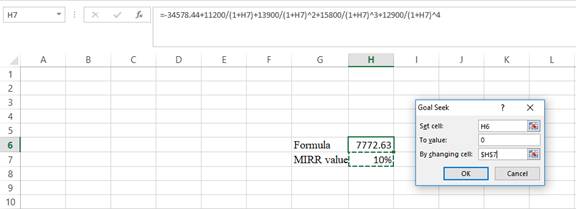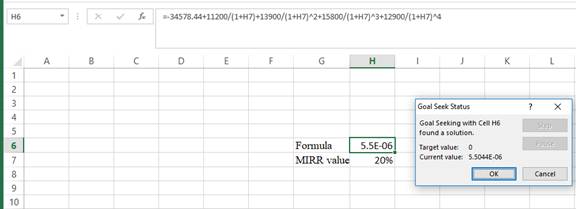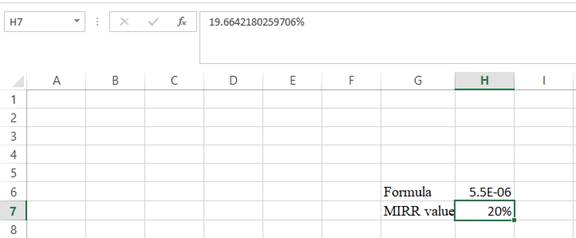
To calculate: The MIRR (Modified
Introduction:
MIRR is the modified internal rate of return, which is a financial measure of attracting the investments. It is utilized in capital budgeting to rank the alternative investments of same size.
Answer to Problem 20QP
The MIRR for the project using the discounted approach is 19.66%, reinvestment approach is 13.95%, and combination approach is 13.49%.
Explanation of Solution
Given information:
Company S is assessing a project, where the cash flows are$11,200, $13,900, $15,800, $12,900, and -$9,400 for year 1, 2, 3, 4, and 5 respectively. The initial cost is $29,000.
Discounted approach:
Note: In this approach, compute the negative cash outflows value for the year 0. On the other hand, the positive cash flows remain at its time of occurrence. The rate of discount is 11%. So, discount the cash outflows to year 0.
Hence, the discounted cash flow at time 0 is -$34,578.44.
Equation of MIRR in discounted approach:
Compute MIRR using a spreadsheet:
Step 1:

- Type the equation of
NPV in H6 in the spreadsheet and consider the IRR value as H7
Step 2:

- Assume the IRRvalue as 10%
Step 3:

- In the spreadsheet go to data, and select What-If-Analysis
- In What-If-Analysis, select goal seek
- In set cell, select H6 (the formula)
- The “To value” is considered as 0 (the assumption value for NPV)
- The H7 cell is selected for the 'by changing cell'
Step 4:

- Following the previous step, click OK in the goal seek status. The goal seek status appears with the IRRvalue
Step 5:

- Thevalue appears to be 19.6642180259706%.
Hence, the MIRRvalue is 19.66%.
Reinvestment approach:
Note: In this approach, compute the
Hence, the reinvesting cash flow at time 5 is $55,708.59.
Equation of MIRR in reinvestment approach:
Compute the MIRR:
Hence, the MIRR is 13.95%.
Combination approach:
In this approach, compute all the cash outflows at year 0 utilizing the rate of discount and all the
Hence, the total
Hence, the value of total cash inflows is $65,108.59.
Equation of MIRR in combination approach:
Compute the MIRR:
Hence, the MIRR is 13.49%.
Want to see more full solutions like this?
Chapter 9 Solutions
Fundamentals of Corporate Finance Standard Edition
- After many sunset viewings at SUNY Brockport, Amanda dreams of owning a waterfront home on Lake Ontario. She finds her perfect house listed at $425,000. Leveraging the negotiation skills she developed at school, she persuades the seller to drop the price to $405,000. What would be her annual payment if she opts for a 30-year mortgage from Five Star Bank with an interest rate of 14.95% and no down payment? 26,196 27,000 24,500 25,938arrow_forwardWhat is an amortized loan?arrow_forwardWhat is the difference between stakeholders and stockholders?arrow_forward
- What are the three general forms of business organization?arrow_forwardWhy should we care about the difference between book value and market value?arrow_forward1. A bond currently has a price of $1,050. The yield on the bond is 5%. If the yield increases 30 basis points, the price of the bond will go down to $1,035. The duration of this bond is closest to: Group of answer choices None of the above 6.0 5 4.5 5.5 2. A callable corporate bond can be purchased by the bond issuer before maturity for a price specified at the time the bond is issued. Corporation X issues two bonds (bond A and bond B) at the same time with thesame maturity, par value, and coupons. However, bond A is callable and bond B is not. Which bond will sell for a higher price and why? Group of answer choices Bond B; bond B should have the value of bond A minus the value of the call option Bond A; bond A should have the value of bond B plus the value of the call option Not enough information Bond A; bond A should have the value of bond B minus the value of the call option Bond B; bond B should have the value of bond A plus the value of the call optionarrow_forward
- In plain English, what is the Agency problem?arrow_forwardHW Question 29: what is the difference between accounting and finance?arrow_forward1. You are assessing the average performance of two mutual fund managers with the Fama-French 3-factor model. The fund managers and the Fama-French factors had the following performance over this periodof time: Manager 1 Manager 2 Rm − rf smb hmlAvg. (total) Ret 27% 13% 8% 2% 6%βmkt 2 1 1 0 0s 1 -0.5 0 1 0h 1 0.5 0 0 1 The risk-free rate is 2%. What kinds of stocks does Manager 1 invest in? Group of answer choices Small-cap value stocks Large-cap value stocks Large-cap growth stocks Not enough information…arrow_forward
- 1. A hedge fund currently invests in $100 million of mortgage-backed securities (MBS) that have a duration of 15 and convexity of -500 (negative five hundred). Which of the following is closest to how much money the fund would gain or lose if interest rates decreased by 1%, using the duration+convexity approximation? Group of answer choices Lose $12 million Lose $10 million Lose $12.5 million Gain $11 million Gain $12 million 2. A hedge fund currently invests in $100 million of mortgage-backed securities (MBS) that have a duration of 15 and convexity of -500 (negative five hundred). Suppose the Hedge fund financed their $100 million of MBS by using seven-day repurchase agreements in addition to their investors’ capital. Assuming they borrow the maximum amount, the required haircut is 10%, and the interest rate is 2% per year, which of the following is closest to how much interest they will owe at the end of the first seven-day term? Group of answer choices $35,000 $40,000 $30,000…arrow_forward1. A 5-year Treasury bond with a coupon rate of 5% per year (semiannual coupons) currently has a quoted price of $100 in the Wall Street Journal. Assuming the last coupon was 60 days ago and there are 364 days per year, which of the following is closest to what you would pay to buy this bond? Group of answer choices $101.000 $100.750 $101.500 $101.250 $100.500 2. Which TWO of the following are correct reasons that could explain why most CFOs still rely on the CAPM to estimate the cost of capital in spite of the fact that it fails to explain the returns on all stocks? Group of answer choices None of the above More investors still only care about the risks captured by the CAPM, and therefore the cost-of-capital given by the CAPM, than any other model The CAPM estimates always underestimate the cost-of-capital, so CFOs can use the CAPM to deceive shareholders into believing their companies are worth more than is actually true There is not necessarily a reliably better/generally…arrow_forwardWhile attending a SUNY Brockport international finance class, Kerry feels inspired to venture into global investments. She's intrigued by a Russian bond promising $110 per year in interest and maturing in 5 years, at which point it will return her initial $1,000 investment. Given an interest rate of 12%, how much does Kerry, the astute Brockport student, lay out for the bond today? -$1,110 -$900 -$963.95 -$1,000arrow_forward
 Essentials Of InvestmentsFinanceISBN:9781260013924Author:Bodie, Zvi, Kane, Alex, MARCUS, Alan J.Publisher:Mcgraw-hill Education,
Essentials Of InvestmentsFinanceISBN:9781260013924Author:Bodie, Zvi, Kane, Alex, MARCUS, Alan J.Publisher:Mcgraw-hill Education,

 Foundations Of FinanceFinanceISBN:9780134897264Author:KEOWN, Arthur J., Martin, John D., PETTY, J. WilliamPublisher:Pearson,
Foundations Of FinanceFinanceISBN:9780134897264Author:KEOWN, Arthur J., Martin, John D., PETTY, J. WilliamPublisher:Pearson, Fundamentals of Financial Management (MindTap Cou...FinanceISBN:9781337395250Author:Eugene F. Brigham, Joel F. HoustonPublisher:Cengage Learning
Fundamentals of Financial Management (MindTap Cou...FinanceISBN:9781337395250Author:Eugene F. Brigham, Joel F. HoustonPublisher:Cengage Learning Corporate Finance (The Mcgraw-hill/Irwin Series i...FinanceISBN:9780077861759Author:Stephen A. Ross Franco Modigliani Professor of Financial Economics Professor, Randolph W Westerfield Robert R. Dockson Deans Chair in Bus. Admin., Jeffrey Jaffe, Bradford D Jordan ProfessorPublisher:McGraw-Hill Education
Corporate Finance (The Mcgraw-hill/Irwin Series i...FinanceISBN:9780077861759Author:Stephen A. Ross Franco Modigliani Professor of Financial Economics Professor, Randolph W Westerfield Robert R. Dockson Deans Chair in Bus. Admin., Jeffrey Jaffe, Bradford D Jordan ProfessorPublisher:McGraw-Hill Education





